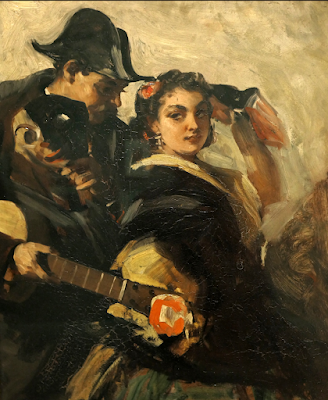 |
| Paul Dash, detail of The Float |
If you hadn’t seen the title as you entered this show, you
could be forgiven for not knowing what is was about. The title is actually Paint
Like the Swallow Sings Calypso, which doesn’t tell you much either, until I
noticed the introductory text explaining that “The Mighty Swallow” was a calypso
singer protesting against inequalities. But I didn’t see much sign of
inequalities in the works of the show.
The phrase “Impressions of Carnival” actually appears on the Kettle’s Yard website describing the exhibition. It serves as a reasonable title, if you interpret it (very) broadly. But the problem for me was not just with the show title, but also at the micro-level, reading and understanding the captions, which contained many unexplained references – for example, what a Schönbartbuch is. Like much in this show, I had to resort to Google and to Wikipedia to get some idea about things being described. It didn’t help that the captions to the works appeared to be in reverse order, so the caption that told you who Paul Dash is appears in the corner of the room opposite the entrance.
Unbelievably billed as bringing together the collections of Kettle’s Yard and the Fitzwilliam for the first time, it looked to me that the genesis was an invitation to three artists, Paul Dash, Errol Lloyd and John Lyons (who is also a writer), to see what they found interesting in the two collections, and what comparisons could be made (or “in dialogue”) with their own. So this kind of explains why we get two Crucifixions, one by Graham Sutherland, and one by the curators – but what does that have to do with Carnival? We also get an abstract work entitled “Torture”, and a sweet little work by William Orpen accepting an invitation to his friend Charles Conder’s party. There is a Picasso print, mistakenly called an oil painting, about the Minotaur, although I fail to see any connection with carnival. If there is one, could they tell us, so we can all share it?
On the positive side, if we become a bit more relaxed about the ostensible theme, there are some lovely works. Paul Dash does some very good scenes of groups of people, done almost entirely with pen and ink.
 |
| Avinash Chandra, detail of Black Feast |
Avinash Chandra has a tumultuous scene that could be many
people, or could just be an abstract pattern, in a lovely combination of
yellow, orange and black. A 17th-century engraving of a Bacchanal shows putti
dancing in an exquisite horizontally oriented print. Fritz Moeser’s Monstrous
head breathing is a fine linocut.
 |
| John Phillips, Spanish Carnival (no date) |
And, finally, a real gem from the Fitzwilliam collection, Spanish
Carnival, by John Phillip. It sounds a hackneyed topic, and I’ve never
heard of the artist, and I wouldn’t be surprised if it has never been exhibited
in the galleries. But the painting, viewed close-up, has a wonderful immediacy;
two figures have just removed their masks, and the woman seems to be captured in
the act of turning to face the viewer, while the man, holding a guitar, is intimately
close behind her. It would be an achievement for a photography to capture such
immediacy.
But for me, this show would be all the better for some further investigation: where did the Caribbean carnival originate? Was it brought from Europe via the masked ball? In this show we have a masked ball (although I struggled to find any masks in it). It shouldn’t be difficult to document the connection, the development, and the modern-day manifestations. Wikipedia has no fewer than 16,500 words on the topic “Carnival”. That would make a useful start.


